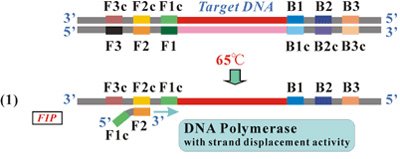- TOP
- About LAMP
- Basic principle
Basic principle
Basic principle
When the target gene (DNA template as example) and the reagents are incubated at a constant temperature between 60-65°C, the following reaction steps proceed:
Producing the starting structure
STEP1
As double stranded DNA is in the condition of dynamic equilibrium at the temperature around 65°C, one of the LAMP primers can anneal to the complimentary sequence of double stranded target DNA, then initiates DNA synthesis using the DNA polymerase with strand displacement activity, displacing and releasing a single stranded DNA. With the LAMP method, unlike with PCR, there is no need for heat denaturation of the double stranded DNA into a single strand. The following amplification mechanism explains from when the FIP anneals to such released single stranded template DNA.

STEP2
Through the activity of DNA polymerase with strand displacement activity, a DNA strand complementary to the template DNA is synthesized, starting from the 3' end of the F2 region of the FIP.

STEP3
The F3 Primer anneals to the F3c region, outside of FIP, on the target DNA and initiates strand displacement DNA synthesis, releasing the FIP-linked complementary strand.

STEP4
A double strand is formed from the DNA strand synthesized from the F3 Primer and the template DNA strand.

STEP5
The FIP-linked complementary strand is released as a single strand because of the displacement by the DNA strand synthesized from the F3 Primer. Then, this released single strand forms a stem-loop structure at the 5' end because of the complementary F1c and F1 regions.

STEP6
This single strand DNA in Step (5) serves as a template for BIP-initiated DNA synthesis and subsequent B3-primed strand displacement DNA synthesis. The BIP anneals to the DNA strand produced in Step (5). Starting from the 3' end of the BIP, synthesis of complementary DNA takes place. Through this process, the DNA reverts from a loop structure into a linear structure. The B3 Primer anneals to the outside of the BIP and then, through the activity of the DNA polymerase and starting at the 3' end, the DNA synthesized from the BIP is displaced and released as a single strand before DNA synthesis from the B3 Primer.

STEP7
Double stranded DNA is produced through the processes described in Step (6).

STEP8
The BIP-linked complementary strand displaced in Step (6) forms a structure with stem-loops at each end, which looks like a dumbbell structure. This structure serves as the starting structure for the amplification cycle in the LAMP method (LAMP cycling). The above process can be understood as producing the starting structure for LAMP cycling.

Cycling amplification step
A dumbbell-like DNA structure is quickly converted into a stem-loop DNA by self-primed DNA synthesis. FIP anneals to the single stranded region in the stem-loop DNA and primes strand displacement DNA synthesis, releasing the previously synthesized strand. This released single strand forms a stem-loop structure at the 3' end because of complementary B1c and B1 regions. Then, starting from the 3' end of the B1 region, DNA synthesis starts using self-structure as a template, and releases FIP-linked complementary strand (Step (9)).
The released single strand then forms a dumbbell-like structure as both ends have complementary F1 - F1c and B1c - B1 regions, respectively (Step (11)). This structure is the 'turn over' structure of the structure formed in Step (8).
Similar to the Steps from (8) to (11), structure in Step (11) leads to self-primed DNA synthesis starting from the 3' end of the B1 region. Furthermore, BIP anneals to the B2c region and primes strand displacement DNA synthesis, releasing the B1-primed DNA strand. Accordingly, similar structures to Steps (9) and (10) as well as the same structure as Step (8) are produced. With the structure produced in Step (10), the BIP anneals to the single strand B2c region, and DNA synthesis continues by displacing double stranded DNA sequence.
As a result of this process, various sized structures consisting of alternately inverted repeats of the target sequence on the same strand are formed.
